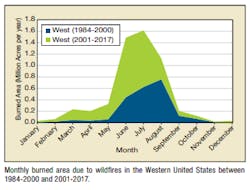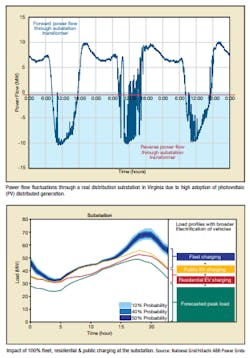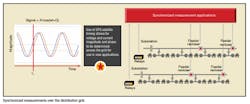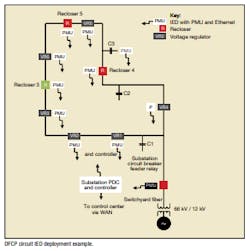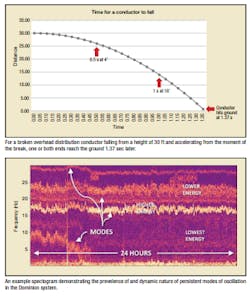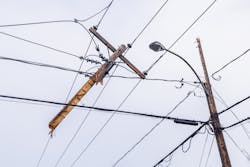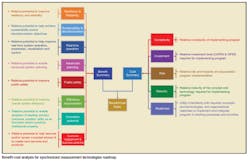Advance the Distribution Grid with Synchronized Measurements
Utilities are facing new distribution system challenges, including the growing adoption of distributed energy resources, transportation electrification, the increasing frequency of major weather events, and the evolving customer expectations of service reliability, resilience and power quality. Synchronized measurements are a necessary tool for addressing grid issues associated with these change drivers, thereby ensuring successful decarbonization efforts.
Synchronized measurements deployed in distribution substations and on circuits can provide high-resolution time-synchronized data to support decarbonization initiatives, integration of renewables and DER, adoption of electric transportation and climate change readiness. Therefore, it is a critical component in the portfolio of solutions and overall grid modernization strategy of electric utilities.
Change Drivers
In the specific case of severe weather impacts, challenges are diverse and vary by geographic region. For instance, in some areas, the severity and duration of droughts, strong winds and associated impacts (for example, dry flammable vegetation) are increasing. In other areas, the frequency and magnitude of severe summer and winter storms are growing. As a consequence, utilities on the West Coast of the U.S. face unprecedented wildfire risk levels, and utilities on the Gulf of Mexico and East Coast face impacts from increasing precipitation, strong winds, flooding, storm surge and quick, dramatic temperature swings. An increase in the average temperature also is a critical concern because it can subject utility assets to significant stress and increase failure risk. Distribution grids are particularly vulnerable to these events given their extent, location, largely overhead design and exposure to external factors such as aggressive vegetation.
The deployment of renewable generation, energy storage and distributed energy resources (DER) in general is a key component of meeting clean energy targets. According to the U.S. Energy Information Administration (EIA), on March 29, 2022, wind surpassed coal and nuclear generation and is currently the second largest source of U.S. electricity generation. Trends in the deployment of wind and solar power are projected to continue to increase as more states adopt clean-energy standards.
DER integration in distribution grids represents a substantial challenge for utilities because distribution circuits and substations have not been designed for variable generation interconnection. Impacts can include voltage rise, voltage fluctuations and reverse power flow. Depending on photovoltaic (PV) penetration, native substation loading and clouding patterns, power flow can change direction (from forward to reverse power and vice versa) in a matter of minutes. This quick change in direction can introduce additional challenges, such as frequent operation of volt-volt-ampere-reactive (volt-VAR) control devices, that need to be investigated and addressed. Transmission grid stability also can be subject to dynamic performance issues, such as both chronic and acute oscillatory behavior of distribution connected energy resources.
Utilities also are working to support the adoption of electric transportation. According to the EIA, electric vehicle sales in the U.S. grew significantly in 2021. Electric vehicles, particularly in fleets, can increase distribution system peak demands considerably, create potential overloads and low-voltage violations, and trigger capital investments to increase capacity (for example, upgrade substation transformers and reconductor distribution lines).
While some of these challenges traditionally have been addressed by the deployment of foundational infrastructure such as grid hardening, a comprehensive solution to this problem must also include the implementation of advanced digital technologies like monitoring, protection, automation and control. Synchronized measurement technologies are an important component of this approach because they can enable the detailed understanding of asset condition and system performance (through descriptive and predictive analytics) and enable proactive mitigating actions. With the use of synchronized measurements, utilities can optimize their investments and minimize or prevent the impact, to the extent possible, of system disruptions.
Synchronized Measurements
Synchronized measurements refer to electric variables measured at locations across the grid with a precise common time stamp at every location. Variables include but are not limited to voltage and current magnitudes, phase angles, power, frequency, rate of change of frequency, and circuit breaker and recloser status.
Meters and relays sample voltage and current signals simultaneously on a common time reference and can be used to compute the magnitude and phase angle of all the signal inputs for their specific location. However, a common wide-area time reference is required to determine the voltage and current signals across a power system. The common time reference can be the time signal from global positioning system (GPS) satellites. This enables all voltage and current phasors to be synchronized across the grid for use in advanced applications. Another differentiating characteristic of synchronized measurements is they benefit from sampling and reporting rates that are one order or more orders of magnitude greater than traditional grid-sensing capabilities. This characteristic enables utilities to observe higher frequency phenomena, such as transients, oscillations, harmonics, and rapid variations of load or generation.
Synchronized measurement technologies have been used successfully for years in transmission grid applications. In the last decade, interest has been growing in this technology for distribution systems and initial applications have emerged. Voltage and current phasors can be collected from around the distribution grid by relays, controllers of recloser, voltage regulators, capacitor banks and other devices. Devices that provide such synchronized phasors typically are referred to as phasor measurement units (PMUs). PMU measurements with consistent timing reference can be reported to central locations like control centers, where they can be analyzed and used in advanced real-time applications.
Wildfire Application
One of the first advanced applications of using synchronized measurements in distribution systems is wildfire risk. When distribution line conductors fail and fall to the ground, the resulting high-impedance arcing fault may be difficult to detect electrically yet capable of igniting dry flammable vegetation or creating an electrical hazard for people in the vicinity of the live downed conductor. As part of a broad program, San Diego Gas & Electric Co. (SDG&E) pioneered the development of a distribution falling conductor protection (DFCP) system that collects streaming synchrophasor measurements from strategic distribution circuit locations and can detect a conductor break in tens of milliseconds.
SDG&E’s analysis application opens circuit breakers or switches adjacent to the break long before falling overhead conductors have reached the ground, preventing wildfire ignition, according to an article published in the January-February 2022 issue of IEEE PES Power & Energy Magazine. The article, “Managing Wildfire Risks: Protection System Technical Developments Combined With Operational Advances to Improve Public Safety,” states that for a broken overhead distribution conductor falling from a height of 30 ft. (9 m) and accelerating from the moment of the break, one or both ends reach the ground 1.37 sec later. The DFCP scheme can detect the break from circuit voltage signatures and issue trip commands so the broken circuit section is deenergized 200 msec to 500 msec after the break — when the conductors have fallen only a few feet — and before they touch the ground. Therefore, there is no difficult-to-detect arcing fault, and wildfire and public safety risks are minimized.
The system uses PMU-enabled protection and control intelligent electronic devices (IEDs) along the distribution circuit, an Ethernet circuit-area high-speed data communications system, and a substation-based phasor data concentrator (PDC) that streams collected synchrophasor streams to an adjacent real-time automation controller. The controller receives a new set of phasor frames from across the monitored circuit 30 times/sec or 60 times/sec. The substation scheme controller in a distribution substation with arrays of circuit IEDs holistically processes all the circuit measurements with algorithms to detect the break between two measurement locations. If the substation controller detects a conductor break, it sends high-speed tripping commands to circuit switching devices (for example, reclosers, circuit breakers or high-speed transfer switches) over the same communications network used to collect the synchrophasor measurements used by the algorithms, typically within 200 msec of detection
Situational Awareness
As the penetration levels of DER and electric vehicles increase, it becomes more critical to collect data and observe the impacts on operation and planning of the distribution grid. This importance has prompted increasing interest in deployment of synchronized measurement technologies in distribution systems. For instance, Commonwealth Edison Co. (ComEd) has deployed more than 100 PMUs in 22 distribution substations for a variety of applications, including microgrid and DER monitoring (solar PV and energy storage) and real-time distribution system operations.
Similarly, as part of its grid transformation plan (GTP), Dominion Energy Inc. is planning to pilot the deployment of distribution synchronized measurements at key locations in select distribution substations to monitor and analyze power-frequency events as well as power-quality meters to capture high frequency harmonic behavior and transient events. Synchrophasors enhance event analysis because the data is more complete and accurate, as it is collected up to 300 times as often as data available from SCADA.
Synchronized measurement technology is commercially available in distribution system protection and control equipment, such as overcurrent protection relays, controllers (for example, recloser, capacitor bank and voltage regulator controllers) and sensors (for example, micro-PMUs). Many existing microprocessor-based relays and controllers used in distribution applications and some substation power-quality devices can provide synchronized measurements if a suitable streaming communications channel is available. High-resolution, time-synchronized data (magnitude and phase angles of voltages and currents) can be used to improve wide-area situational awareness and understand and enhance overall distribution substation and circuit performance.
Technology Benefits
The benefits of deploying synchronized measurement technologies in distribution systems are as follows:
DER impact mitigation — DER adoption and saturation can cause reverse power flow through distribution substation transformers and circuits, impact protection systems and schemes, which can lead to voltage fluctuations and interactions with voltage regulation equipment (load-tap changers). Synchronized measurement technologies allow high-resolution, time-synchronized monitoring and control of substation and circuit assets as well as settings in real time.
These capabilities can be used to implement mitigation measures (for example, adjustment of protection and voltage regulation settings for reverse power flow operation) to prevent or alleviate impacts caused by DER adoption (for example, reach modification and desensitization). DERs also can provide benefits to the grid (for example, dynamic volt-VAR support, reliability and resilience improvement through intentional islanding operation and microgrids) when managed and operated correctly and when suitable enabling technology is in place. Synchronized measurement technologies are key elements to enable and validate these types of benefits provided by DERs.
Dynamic performance monitoring of DER and power electronics — Both DER and the compensatory devices installed to counteract impacts of DER on the grid
interconnect through power electronics interfaces. These types of interfaces contribute not only to power-quality issues but also to dynamic and small-signal stability of the grid. The ability to model and predict the behavior of these interfaces through simulation is severely limited.
As more and more renewables are brought on-line, more and more power electronics compensation devices also brought on-line. As a whole, the likelihood of local and system-wide impacts grows exponentially. However, a
solution exists: High-resolution telemetry such as synchrophasor and waveform data combined with contemporary analytical techniques can identify, track, diagnose and enable mitigation of oscillatory behaviors. As a limiting factor, removal of these behaviors thereby maximizes the effectiveness of renewable integration on
a per-megawatt basis.
Electric transportation impact mitigation — Electric vehicle adoption and saturation can increase distribution substation and circuit peak loading and average asset
utilization (for example, modification of load factors). Real-time monitoring capabilities are key to evaluating substation asset thermal limits and implementing
advanced and more effective voltage regulation control strategies that consider fast demand changes in electric vehicle charging stations, DER outputs and native loads of customers. Additionally, as technology, regulation and policy evolve, it is expected vehicle-to-grid (V2G) operation of electric vehicles will become more common; this type of operation — either alone or when combined with advanced operation of DERs — can support grid operations (for example, voltage regulation, reactive power support and peak shaving) and provide additional benefits to the grid and customers. Synchronized measurement technologies can help to enable and
validate these types of benefits. Improved reliability — The deployment of synchronized measurement technologies can help to enhance wide-area awareness, real-time visibility, asset loading evaluation, and DER and electric transportation impact mitigation as well as ultimately enhance distribution substation and circuit performance, which, along with advanced analytics capabilities, can improve the overall reliability and resilience of the power delivery system.
Improved power quality — Synchronized measurement technologies can enable the detection of voltage and current issues such as frequent voltage sags and swells, short- and long-term flicker, total harmonic distortion, and voltage and current imbalance. This information can be used to evaluate overall power-quality performance, identify root causes of power-quality issues, and implement solutions to alleviate impacts and improve performance.
Improved resilience — The real-time monitoring and control and advanced analytics capabilities of modern substations enable the implementation of control actions to adapt to changing system conditions and external variables (for example, weather). This increased adaptability improves resilience and reliability by allowing the overall power delivery system to withstand or recover faster from disruptive events.
Improved asset health — The high-resolution data collected by modern distribution substations and circuits through advanced sensors such as PMUs can be used to evaluate overall asset health. Examples of data that can be used for this type of application include asset loading, asset operation and other relevant parameters (for example, voltages and temperatures).
Effective maintenance — The high-resolution data collected from key assets (for example, distribution substation transformers, circuit breakers and
reclosers) can be used proactively to identify potential performance deterioration as a result of incipient faults, for instance. This information can be used to implement preventive solutions that address the identified issues and root causes.
Industry Road Map
Quanta Technology LLC, Oak Ridge National Laboratory (ORNL) and SDG&E partnered to develop an industry framework and a high-level industry road map for deploying distribution synchronized measurements for electric power system modernization. The project was supported by the U.S. Department of Energy (DOE) to identify the optimal distribution of synchronized measurement technologies and create a road map for future investments. The project included interviews with Consolidated Edison Co. of New York Inc. (Con Edison), Dominion Energy, and Commonwealth Edison (ComEd) to identify key areas of interest for the industry where deployment of synchronized measurement technologies could provide value to utilities and customers. Published on Sept. 27, 2021, the road map was based on a framework and methodology for quantifying relative benefits and costs for applications as well as associated infrastructure and developing application priorities.
A total of 75 applications were identified and mapped into 19 different application groups. Each application group was evaluated in terms of the benefit-cost ratio. The benefit-cost analysis and prioritization of application groups was conducted based on relative value to address key industry needs and relative implementation costs.
Relative benefits were evaluated based on the following:
1. Resilience and reliability
2. Sustainability and decarbonization
3. Real-time operation
4. Advanced planning
5. Public safety
6. Efficiency improvement
7. Innovation potential
8. Customer engagement and business potential.
Relative costs were evaluated based on complexity, investment, risk, maturity and readiness. Each benefit and cost category was assigned a weight to model its relative importance based on the project team’s technical opinion and industry experience.
Application groups were graded for the benefit and cost categories using a scale from 0 to 10. Then the results were used to calculate a benefit-cost ratio to prioritize the application groups.
The top application groups were identified using this methodology to create an industry application road map. While the DOE road map is based on experience of industry and subject matter experts (SMEs), the road map for an individual utility may differ. Individual utility drivers, needs and challenges likely will result in a different prioritization. However, the same methodology used in the project can be used by utilities to determine their own application roadmap.
What Is Next?
As utilities continue to work on decarbonization initiatives, integration of renewables and DER, adoption of electric transportation and climate change readiness, there will be an increasing need to understand and proactively manage the distribution system and active components attached to it, to optimize operations, improve performance and minimize system disruptions. Synchronized measurements deployed in distribution substations and on circuits can provide high-resolution time-synchronized data to support these activities. Therefore, it is a critical component in the portfolio of solutions and overall grid modernization strategy of electric utilities.
Reviewing the requirements of the applications shows most of them can be achieved with the existing hardware and software products available on today’s market. However, adopting new technologies will impact utilities comprehensively. An organizational plan should identify the operating groups and roles for the system architecture, communications infrastructure, application design, data archiving and storage, ongoing support (such as maintenance or repair), training and diagnostics tools.
Kevin D. Jones ([email protected]), Dominion Energy Inc. received his Ph.D. from Virginia Polytechnic Institute & State University as a Harry Lynde
Bradley Fellow in 2013 where he studied synchrophasor technology, wide area measurement systems, and linear state estimation. Kevin developed the open-source Linear State Estimator, now commercialized by several industry vendors, used for improving resiliency of real-time transmission control centers. While at Dominion, Kevin developed the Analysis On Demand (ANODE) platform, increasing the analytic throughput of the outage planning team by more than 1000x. He championed much of Dominion’s synchrophasor data program over the last decade and now oversees an organization of approximately 30 engineers who focus on physics-based modeling and simulation, data-driven operations support, and engineering analysis of time-series sensor data from the electric transmission grid.
Ludo Hintos ([email protected]) MSEE, PE, is Manager — Electric Distribution System Grid Planning at Dominion Energy. Ludos has more than 14 years of experience in technical and leadership positions with electric utilities. He received his degrees in electrical engineering from George Mason University and is currently based in Moseley, Virginia.
Julio Romero Agüero ([email protected]) PhD, MBA, Executive Advisor, Vice President, Strategy & Business Innovation, Quanta Technology, LLC has 27 years of experience, he provides leadership to Quanta Technology in the areas of strategy, innovation, grid modernization, distribution systems planning, reliability, resiliency, and integration of distributed energy resources and emerging technologies. He has developed solutions in these areas for electric utilities and regulatory boards in the USA, Canada, Latin America, the Caribbean, and Asia. He is a Senior Member of the IEEE and currently serves as Vice President, Membership & Image in the IEEE PES Governing Board. He has served as Chair of the 2020 and 2021 Innovative Smart Grid Technologies Conference – North America (ISGT – NA), Chair of the IEEE Distribution Subcommittee, Chair of the IEEE Working Group on Distributed Resources Integration, Editor of IEEE Transactions on Power Delivery, and Editor of IEEE Transactions on Smart Grid. He is a Distinguished Lecturer of IEEE PES and an Adjunct Professor at University of North Carolina at Charlotte.
David Hart, PhD ([email protected]), Executive Advisor, Vice President, Protection, Control & Automation, Quanta Technology, LLC has more than 30 years of experience in the power industry, including protection and control, power system automation, smart metering, and AMI systems. Over his career, he has developed numerous protection and control products. Before his work at Quanta Technology, David held management positions at ABB, where he developed protection products and developed AMI products and systems at Elster, where he was responsible for the engineering, product management, and quality organizations. At Quanta Technology, David and his team provide consulting support to utilities on protection and control, AMI systems, feeder automation, analytics, coordination studies, and advanced applications. As the direct head of Protection, Control, and Automation area, he guides the overall business strategy, client and program proposals, and project execution. David holds a PhD in Electrical Engineering from Clemson University and is a senior member of IEEE/PES. His work has earned significant recognition throughout his career, including more than 30 technical patents and numerous articles in industry publications.
Eric Udren ([email protected]) Executive Advisor, Advisory Services, Quanta Technology, LLC has over 50 years of experience leading the design and application of protective relaying systems, substation control, wide-area monitoring and control systems, phasor measurement unit (PMU) applications, and
communications systems. Eric is an IEEE Life Fellow, holds 12 U.S. patents, and is the author of over 90 papers and book chapters, including Westinghouse’s Applied Protective Relaying. Eric was the Industry Guru of PAC World Magazine in September 2016. He was elected as a 2019 member of the National Academy of Engineering “for leadership in advancing protection technologies for electric power grids.” Eric earned an MS in Electrical Engineering from the New Jersey Institute of Technology, a Certificate of Post-Graduate Study from Cambridge University, and a BS in Electrical Engineering from Michigan State University.
Rich Hunt ([email protected]) MS, PE, Executive Advisor, Protection, Control & Automation, Quanta Technology, LLC has over 30 years of experience in the electric power industry, emphasizing protective relaying. Over the last 15 years, his focus has been on all aspects of specifying and designing digital substations, including IEC 61850, process bus, non-conventional instrument transformers, networking, and time synchronization. Rich earned his BSEE and MSEE from Virginia Tech, is a Senior Member of IEEE, a member of the Main Committee of the IEEE Power System Relaying & Control Committee, the US representative to the CIGRE B5 Technical Committee, and is a registered Professional Engineer.
Companies Mentioned
ComEd | www.comed.com
Con Edison | www.coned.com
ORNL | www.ornl.gov
SDG&E | www.sdge.com
About the Author
Kevin Jones
Kevin Jones is a business development manager with ACRT. With more than 10 years of experience, he has played a significant role in the growth of ACRT and has helped to shape the industry. Jones holds a bachelor’s degree in horticulture from the Ohio State University.
David Hart
Director, E4tech
David Hart has consulted and carried out research on fuel cell and hydrogen issues for a wide range of organisations worldwide, including national governments, major industrial companies, financial organisations and NGOs. In addition to his work as a Director of E4tech, he is also a Visiting Professor at Imperial College London’s Centre for Environmental Policy, and chairs the Steering Committee of the Grove Fuel Cell Symposium, one of the leading global fora for fuel cell experts. David is recognised as one of the leading experts in hydrogen energy technology and infrastructure, and the associated policy and environmental issues; and in fuel cells used for transport, portable and stationary decentralised power generation. He has led over a dozen fuel cell and hydrogen assessments for due diligence work, in addition to strategic analyses and a wide variety of reports and papers, and has been an invited keynote speaker on fuel cell and hydrogen issues on six continents. David holds degrees in Mechanical Engineering with German from the University of Bath and in Environmental Technology from Imperial College, and his PhD at Imperial College was in Hydrogen Energy Systems.
E4Tech is a sustainable energy consultancy based in London and Lausanne.
Ludo Hintos
Ludo Hintos ([email protected]) is manager of electric distribution system planning. Ludois responsible for the development of electric distribution power grid across the Dominion Energy Virginia footprint. The team Hintos leads plans and designs new electric distribution grid to safely and reliably power the most complex and largest customer base including data centers and Amazon HQ2. Additional responsibilities include Grid Transformation Plan (GTP) testimony preparation and program implementation, capital budget management, electric distribution fault protection analysis, planning and commissioning of distributed energy resources, power quality, distribution network and system automation. Hintos joined the company in 2008 as an Engineer I in Electric Distribution Design. In 2009, he transitioned to Electric Distribution Grid Planning where he was promoted to an Engineer II. During his time in Northern Virginia, Hintos has held multiple leadership roles in both operations and design including Shift Manager of the Northwest Regional Operations Center and Manager of Electric Distribution Design, NW. He moved into his current role in Richmond, in October 2020. Hintos earned a bachelor’s and master’s degree in electrical engineering from George Mason University. Hintos is a licensed Professional Engineer in Virginia.
Julio Romero Agüero
Julio Romero Agüero, PhD, MBA, Executive Advisor, Vice President, Strategy & Business Innovation, Quanta Technology, LLC has 27 years of experience, he provides leadership to Quanta Technology in the areas of strategy, innovation, grid modernization, distribution systems planning, reliability, resiliency, and integration of distributed energy resources and emerging technologies. He has developed solutions in these areas for electric utilities and regulatory boards in the USA, Canada, Latin America, the Caribbean, and Asia. He is a Senior Member of the IEEE and currently serves as Vice President, Membership & Image in the IEEE PES Governing Board. He has served as Chair of the 2020 and 2021 Innovative Smart Grid Technologies Conference – North America (ISGT – NA), Chair of the IEEE Distribution Subcommittee, Chair of the IEEE Working Group on Distributed Resources Integration, Editor of IEEE Transactions on Power Delivery, and Editor of IEEE Transactions on Smart Grid. He is a Distinguished Lecturer of IEEE PES and an Adjunct Professor at University of North Carolina at Charlotte.. E-mail: [email protected]
Rich Hunt
Rich Hunt, MS, PE, Executive Advisor, Protection, Control & Automation, Quanta Technology, LLC has over 30 years of experience in the electric power industry, emphasizing protective relaying. Over the last 15 years, his focus has been on all aspects of specifying and designing digital substations, including IEC 61850, process bus, non-conventional instrument transformers, networking, and time synchronization.
Rich earned his BSEE and MSEE from Virginia Tech, is a Senior Member of IEEE, a member of the Main Committee of the IEEE Power System Relaying & Control Committee, the US representative to the CIGRE B5 Technical Committee, and is a registered Professional Engineer. E-mail: [email protected]
Eric Udren
Eric Udren ([email protected]), Executive Advisor, Advisory Services, Quanta Technology, LLC, has over 50 years of experience leading the design and application of protective relaying systems, substation control, wide-area monitoring and control systems, phasor measurement unit (PMU) applications, and communications systems. Eric is an IEEE Life Fellow, holds 12 U.S. patents, and is the author of over 90 papers and book chapters, including Westinghouse’s Applied Protective Relaying. Eric was the Industry Guru of PAC World Magazine in September 2016. He was elected as a 2019 member of the National Academy of Engineering “for leadership in advancing protection technologies for electric power grids.” Eric earned an MS in Electrical Engineering from the New Jersey Institute of Technology, a Certificate of Post-Graduate Study from Cambridge University, and a BS in Electrical Engineering from Michigan State University.

